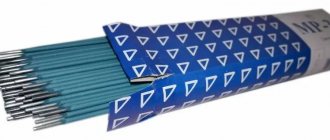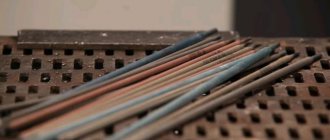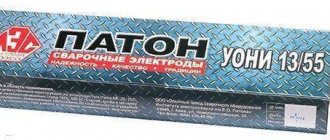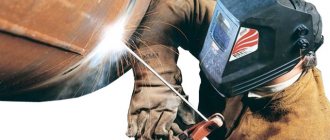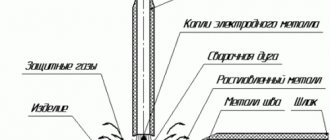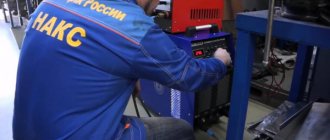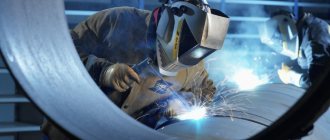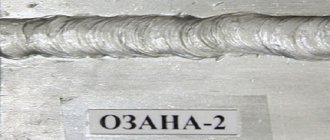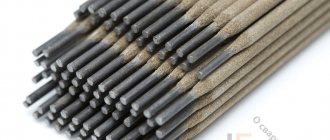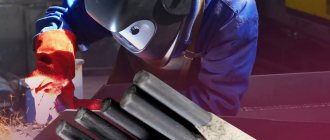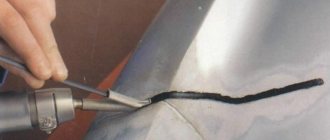The use of electrodes in the welding process is widespread today. It is almost impossible to give an unambiguous answer regarding the choice of brand of electrode products, because the subjective opinion of the welder is integrally involved in the selection process.
In today’s article I will try to analyze as objectively as possible which electrodes to choose for welding with an inverter for a beginner + what according to TM in 2021-2022 is considered the most relevant for use by welders.
Which electrodes are better
First of all, it is necessary to list the criteria according to which the selection of electrical conductors occurs:
- Beginner welders are recommended to use rutile-coated consumables; for experienced welders, rod coating does not play an important role;
- electrodes can be consumable and non-consumable;
- it is necessary to determine the design, product or equipment of what type to be welded;
- the choice also depends on the grade of steel being processed (see purpose);
- thickness of products;
- The type of work also has a significant impact: complex and massive structures are welded with large-diameter electrodes, welding of profile elements is carried out with materials up to 2 mm in diameter;
- type of welding current and polarity of its connection;
- and not the least role is played by the quality of welding electrodes.
Do not use materials with chipped coating!
For newbies
Most often, the question about which ones are better and which ones are worse is asked by beginners, so let's start with what are good electrodes for beginners. As stated earlier, the preferred electrode option for beginners is rutile-coated rods. This is due to the fact that this type of conductor is characterized by ease of use.
The most popular brands with rutile coating:
- ANO-4.
- MP-3.
- OK 46.00 (in the picture).
- UTP 65D.
For household welding
Household welding is characterized by a low level of complexity, as well as the absence of special requirements for the reliability and quality of the weld. Ease of operation is expected. Therefore, we will separately consider good electrodes for household welding.
Household welding includes work on the manufacture of small structures (for example, welding of fencing systems (fences), greenhouse frames, etc.), performing small work in a garage or at the construction site of a private house.
ANO electrodes (in the picture on the right) are most often chosen for welding at home. This brand is suitable for working with almost all types of welding inverters. Therefore, it has become widespread among beginners and home craftsmen.
Conductors of the MP-3 brand are distinguished by their versatility and unpretentiousness. These consumables allow you to weld even wet, rusty and poorly cleaned surfaces.
UONI - electrodes for a durable seam, have a more capricious “character”. To weld this brand, you must have certain skills, but SSSI can be used for welding surfaces of any complexity. [ads-pc-2][ads-mob-2]
For welding stainless steel
Welding electrode EA-400/10T.
Now, which electrodes are better for welding stainless steel. Many home craftsmen are often interested in the question: is it possible to weld stainless steel with conventional electrodes? It is possible to connect stainless steel with this type of consumables, but it is not entirely professional and the welding seams may soon become covered with rust.
List of the most popular brands of electrodes for welding stainless steel:
- NZh-13.
- OZL-8.
- TsL-11.
- TsT-15.
- EA-400/10T.
- OK 63.30.
Video
Watch a short video that demonstrates welding stainless steel with a “black” electrode, but as you can see from the ratings of the video and comments on the video, such welding causes mixed opinions among professionals and amateurs.
The full list can be found in the “Stainless steel electrodes” section.
For welding cast iron
Electrodes OZZHN-1
What good electrodes for welding cast iron would you recommend? Cast iron is one of the most popular materials used in a variety of applications and applications. There are several types of cast iron: malleable, gray, high-strength, etc.
As a rule, almost all of the electrodes listed below are suitable for cast iron, but not any type (the electrode must correspond to the grade of metal, but this is a topic for another discussion):
- MNC-2.
- OZZHN-1.
- OZCH-2.
- TsCh-4.
- OK 92.18.
The entire list of electrodes intended for welding cast iron is presented in the section “Electrodes for welding and surfacing of cast iron.”
For pipes
When choosing consumables for welding pipes, the main criterion is the thickness of the product. The thicker-walled the pipe has to be welded, the larger the diameter of the electrode should be.
There are four types of joints that are used when welding pipes:
- end-to-end;
- overlap;
- vtavr;
- in the corner.
The type of connection also affects the choice of electrode brand.
In addition, it should be remembered that the classification of pipes is quite extensive, so choosing the best electrodes for pipes is an incorrectly posed question. To work with critical pipelines, electrodes designed for complex welding processes should be used. Consumables for welding household pipes (for example, water pipes) are not subject to increased requirements for strength and reliability.
Popular brands of welding materials for welding pipes:
- ZIO-20.
- TML-1U.
- UONI-13/55.
- TsU-5.
A complete list is presented in the section “Electrodes for pipe welding”.
It should be noted that LB-52U electrodes are the most popular among professional welders. This brand is excellent for welding critical tanks; gas pipelines, inside of which high pressure is maintained.
Amateurs and novice welders for domestic purposes are recommended to purchase grades with rutile coating: ANO-4, MR-3S, OK 46.00 and others. [ads-pc-3][ads-mob-3]
For inverter
Again, beginners ask the question: “Which welding electrodes are best for an inverter?” On the modern market of welding materials there is a great variety of electrodes for inverters.
Most (and almost all) brands are suitable for equipment of this type, since such units produce direct current. And if the electrode cooks “alternately,” then it will also cook “constantly.”
If a welder has a question about the types of conductor suitable for an inverter, most likely he is a novice specialist. Accordingly, it is recommended to use consumables with rutile coating.
Classification of consumables
| by appointment | designation | |
| for carbon and alloy structural steels with a tensile strength of up to 600 MPa | e38, e42, e42a, e46, e46a, e50, e50a, e55, e60 | at |
| for alloyed structural metals with a tensile strength of more than 600 MPa | e70, e85, e100, e125, e150 | l |
| for heat-resistant materials that have undergone alloying | e09m, e09mkh, etc. | T |
| welding of high-alloy parts with special properties | e12x13, e06x13m, e10x17t, etc. | V |
| surfacing of surface coatings with special characteristics | e10g2, e11gz, e16g2khm, etc. | n |
Identifying common groups among a great variety of options is a difficult task, which not all experienced craftsmen undertake. They are schematically divided according to their purpose, the chemical composition of the fused alloy, types, thickness, material from which they are made, and mechanical properties. Experienced specialists use those consumables that they are used to, or those that satisfy them in terms of price and quality ratio. When choosing, they usually take into account two criteria:
- The type of metal you will need to work with. If welding work is carried out at home, then most often we are talking about iron and alloys based on it - the so-called ferrous ones. In this case, the only thing a beginner should consider is the carbon content. Find out what kind of steel you will be dealing with: high, medium, low carbon or cast iron. Acquaintance also often has to start with “stainless steel”.
- Design requirements. Before deciding which electrodes to choose for inverter welding and how, it is necessary to understand whether the seams will be subject to vibration loads or temperature changes. In this case, you should pay attention to rods with enhanced properties.
What kind of coverage is needed?
There are four main types of coating, each of which has its own distinctive properties.
1. Acid coating is mainly composed of iron, manganese, silicon and other chemical elements. Electrodes with this type of coating are marked with the letter “A”. Advantages of acid-coated consumables: high resistance to the appearance of air channels in the welded joint; the ability to process rusty products and parts with scale. The main disadvantage is the risk of hot cracks appearing in the weld metal.
2. Electrical conductors with cellulose coating are designated by the letter “C”. A special feature is the high content of organic substances (mass fraction can reach 50%): cellulose, organic resins, ferropalms, etc. When burned in an arc, this type of coating releases a large amount of protective gases and a small amount of slag. This guarantees the convenience of welding work in a vertical position. Disadvantages : high hydrogen content when working with steel can negatively affect the characteristics of the deposited metal; significant amount of splashes.
3. Rutile electrodes are marked with the letter “P”. The basis of the coating is rutile, as well as some silicon and oxygen content. This type is characterized by quiet melting, a small amount of spatter, easy slag separation, and the seam has a fine pattern. An important feature is the ease of re-ignition of the arc. Welding work should be carried out in conditions of normal humidity and after calcination of the materials, otherwise the quality of the connection deteriorates and signs of oxidation appear.
4. The main coating of the electrodes is designated by the letter “B” and consists of magnesium and calcium carbonates. Conductors with this type of coating are designed to operate on direct current, as well as for connecting critical structures and pipelines. The deposited metal has an increased level of ductility and is not prone to oxidation. The main advantage is that the low saturation of this type of coating with hydrogen eliminates the deterioration of the characteristics of steel and other metals. The main disadvantage is the formation of a large amount of slag.
What is a welding inverter?
Welding is a difficult and responsible process. Anyone can master this craft if they wish, but if previously they had to use complex and bulky equipment for work, now it is enough to purchase a welding inverter, which greatly simplifies the task. This is a relatively small device that weighs much less than any other welding machine. This made it possible to simplify and facilitate the welding process. Nowadays, the welding inverter has practically replaced standard welding machines from the market.
How does a welding inverter work? The voltage coming from the mains is supplied to the so-called rectifier, then the direct current is converted into alternating current due to a special power module. But alternating current has a higher frequency. This, in turn, is fed to a welding transformer, and the voltage from it, after rectification, is supplied to a very stable welding arc.
Welding inverter CALIBR SVI-250 4600 W
The main advantages of a welding inverter:
- relatively light weight of the device;
- improvement of arc characteristics;
- increased efficiency;
- the ability to reduce the amount of splashes during work;
- different electrodes can be used;
- wide current adjustment range;
- simplified electrode ignition;
- you can get a more durable and high-quality seam;
- it is easier to master the craft of a welder;
- the electrodes almost do not stick when in contact with the part.
Of course, there are also disadvantages. At a minimum, this is the high cost of the equipment (three times more than conventional transformers). It is also important to clean inverters regularly from dust - at least once a year. And you won’t be able to work with them in the cold - the devices don’t like the cold. Also, the network cable required to connect the device to the electrical network cannot exceed a length of 2.5 m.
Important! It is not always possible to use an inverter for welding at temperatures below -15 degrees. Here it is important to study the instructions for the selected device model and follow the manufacturer’s recommendations.
Popular and best domestic electrodes for welding
ATTENTION! The following information is based on publicly available data at the time of this writing. For greater objectivity, we will make our own rating of welding electrodes, which is given below. We invite you to add your voice.
As a result of marketing research of the welding materials market, the most popular brands in recent years are:
- Resanta.
- SpetsElektrod (Moscow).
- “LEZ”.
The expert rating is as follows:
- KOMZ.
- ESAB-Tyumen.
- “Penzaelectrode”.
- “LEZ”.
- "SEZ".
[ads-pc-4][ads-mob-4]
User voting
Which welding electrodes would you choose or recommend?
Kobelco LB-52U
10.55 % ( 56 )
ESAB SSSI 13/55
8.47 % ( 45 )
Cedar OZL-8
2.26 % ( 12 )
Lincoln Electric SSSI 13/55
6.59 % ( 35 )
Wester UONII-13/55
1.88 % ( 10 )
ESAB-SVEL OK 46.00
32.58 % ( 173 )
Resanta MP-3
21.66 % ( 115 )
Fubag FB3
8.29 % ( 44 )
Sibrtech MP-3C
3.20 % ( 17 )
Ratings
The best (popular) brands of electrodes
Materials for cast iron and stainless steel are not included due to their specificity.
The best (popular) electrode manufacturers
If you see that the ratings are missing a well-deserved brand or manufacturer, write in the comments, they will be added to the survey.
We also recommend that you read the material “How to choose electrodes for welding”, it gives advice based on what exactly you are going to weld.
Purpose
In addition to brand and diameter, they are divided according to their purpose. This also determines which electrodes are best for the inverter. Conventionally, they are divided into the following electrodes:
- For welding carbon or low alloy metals.
- For welding parts made of durable heat-resistant metals.
- For working with stainless steel.
- For working with aluminum and copper alloys or directly aluminum and copper.
- For welding cast iron parts.
- For minor repairs and surfacing.
- Universal-purpose electrodes used for welding parts made of unknown metal.
Foreign manufacturers
Answering the question “Which electrodes to choose for welding with an inverter?” It is worth mentioning foreign manufacturers. There are many brands on our market, but we will focus on European ones. In our opinion, Abicor Binzel, ESAB, Böhler Welding and ELGA are the best.
Whatever manufacturer you choose, their products can be used to carry out all types of welding work: welding carbon steel, pipe joints, performing particularly complex work with difficult-to-weld metal, welding cast iron, copper and aluminum. If you cook to order or perform work with an increased degree of responsibility, then choose foreign manufacturers. Their quality is many times higher than the products of Russian manufacturers, since there is strict control in production.
